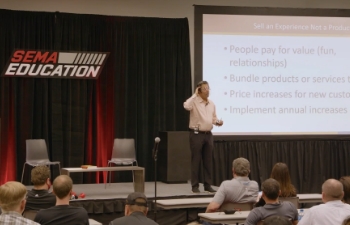SEMA News—December 2020
RETAIL BEST PRACTICES
Dealing With Supply-Chain Disruptions
How Careful Contingency Planning Can Keep Your Customers Happy
 A retailer’s ultimate goal is to build trust and loyalty with consumers. Keeping them honestly and continually informed about parts availability can help keep them from going elsewhere, even when you don’t immediately have the items they need. |
There’s no denying that recent supply-chain disruptions are putting a two-fold crunch on many aftermarket sellers. On one hand, consumer demand for aftermarket products is surging as enthusiasts turn to do-it-yourself automotive projects to while away the hours of COVID-19-induced shutdowns. On the other, scarcity of raw materials, temporary closures or slowdowns of industrial facilities and even hoarding of key items have hindered the ability of brands to speed enough product to warehouse distributors (WDs) and retailers to meet market needs.
According to retail expert Barry Moltz, the usual tendency of small retailers to rely on a single supplier has added to the conundrum.
“In the past, that’s been so reliable that they haven’t looked for other paths or vendors,” he said. “But now, since there’s all sorts of disruption, retailers are thinking, ‘Well, I really should have a backup here, and I never really thought about that.”
As unsettling as the situation might be for retailers, it’s all the more so for consumers.
“I don’t think people ever thought they would be unable to get something when they want to get it, especially in America,” Moltz said. “I mean, who would’ve thought that I would go into a grocery store and not be able to get rice or flour or bread or whatever it is. So it’s kind of like a new reality we’re dealing with.”
The upside is that retailers who can bridge the supply-chain gap can gain a decided advantage in an uncertain market. According to Moltz, whether it’s groceries or vehicle parts and accessories, “People, especially during a pandemic, need help when they need it, and loyalty, in my opinion, is totally up in the air now. If you can’t give it to your customer when they want it, they’re going to go someplace else. The ideal thing is to be able to deliver product when people want it, having multiple sources in your supply chain.”
Bridging the Gaps
Of course, the question is how to do so. Gigi Ho, SEMA Data Co-op vice president of operations, said that there are several possible strategies, starting with improved communication with suppliers and WDs.
“Resellers should run sales history reports and communicate forecasted needs of their best movers to their primary manufacturer,” she advised. “Ideally, one-, two- and three-month forecasts should be supplied. If budget and space allow, bring in inventory to satisfy short-term forecasted requirements. Issuing blanket purchase orders for forecasted quantities with scheduled release dates helps manufacturers immensely in planning production and purchasing.
“The same courtesy forecasting could be used by retailers when working with their WDs. There would be a bit more communication required to make sure of the WD orders to forecast. Again, blanket purchase orders is the best method, as the WD is ordering based off sales and not their relationship with the retailer.”
Another proven tactic is to establish relationships with retailers outside your immediate area to create an informal buying group that can share inventory between stores.
“This lessens the financial burden on any one store and yet achieves the inventory availability they need to capture most sales,” Ho said. “However, this only works for stores with similar clientele and enough geographic distance to avoid pirating sales from each other. Ideally, once inventory is received, it is distributed among ‘member’ stores so they’ll have the products on the shelf—sort of a consignment between stores.”
As retailers shore up their supplier relationships, they should also be looking for ways to increase the trust and loyalty of consumers. One method is to find a needed product in stock at the WD and then reach out to a local enthusiast club with a discount offer for in-store
purchases.
“For example, now that it’s lighting season, if your WD has a great inventory of a popular brand’s lights, contact your local off-road club and offer a group buy,” Ho suggested. “If a certain percentage of members order the lighting, everyone gets a given percentage off.”
Shops that offer installation services should also try to pre-book as many appointments as possible to time installations with product availability. Moreover, if your outlet doesn’t already do so, consider offering some sort of in-store financing. The purchase approval and installation scheduling processes could help buy time while product comes in.
Ho also encouraged retailers to line up contingency WDs.
“There are many regional ones who can help support your store and back up your national or primary source,” she said.
Updating Contingency Plans
If nothing else, the COVID-19 situation presents retailers with an opportunity to reevaluate their business strengths and weaknesses and adjust their operations accordingly. Even if your shop is not experiencing disruptions, Alliant Insurance Services Senior Vice President Bob Corwin recommended taking the time to map out your supply chain and develop a contingency-continuity plan. Review inventory levels and how long they can last without replacement as well as how long the business can sustain itself before tapping financial reserves. Finally, develop your Plan B with suppliers while anticipating the premium costs you might pay for product.
“Every business needs to make sure it has lines of credit available based on assets as collateral—for example, the valuation of an owned building,” Corwin said. “Will the company need to buy time with the line of credit to make payroll and pay general business expenses? The answer here could be yes!”
In certain situations, the right insurance coverage may help a business mitigate its potential losses. Retailers should review their policies, particularly in regard to business income loss and contingent business income coverages. Such coverages can be expanded with supply-chain insurance.
“Losses faced by businesses today generally are occurring in the loss-of-income category,” Corwin said. “What this means is that the business owner cannot receive the products or raw materials to make their product due to a supply-chain disruption and thereby cannot sell product.
“In principle, supply-chain insurance is like contingent business income coverage, but the loss and subsequent payout of business income is a result of a non-physical loss, such as a pandemic, a strike or a riot. There is complexity to getting these coverages to protect a business’s bottom line, so it takes a professional broker to assist with this process. Coverage is available, although pandemic coverage may be limited or unavailable at this time.”
| Sources | |
| Barry Moltz Small-Business Expert www.barrymoltz.com barry@moltz.com 773-837-8250 Bob Corwin Senior Vice President Alliant Insurance Services www.alliant.com bcorwin@alliant.com Gigi Ho Vice President of Operations SEMA Data Co-op www.semadatacoop.org info@semadatacoop.org 888-958-6698 |
Strengthening Customer Relationships
Whatever steps a retailer takes, Moltz underscored the necessity of remaining honest and transparent with customers. If you can’t get product right away, clearly communicate when the consumer can expect it and continue that communication throughout every step of the process.
“What customers don’t want is not knowing,” he emphasized. “You order something that was supposed to come in two days, and it doesn’t arrive in two days. Where is it? If you tell them it’s going to take two weeks to get it, then keep updating them on where it is. That helps a lot.”
Ho agreed: “Communicate! Be upfront with your customers. They came to you because they value your experience and opinion, so if a product is on backorder or out of stock, let them know and offer an alternative product if possible. They will appreciate your honesty.”
That said, Moltz also cautioned against apprising consumers of supply-chain difficulties in broader marketing and social-media messaging.
“I think the customer only wants to know how it affects them,” he said. “They don’t care if you’re having general problems.”
In the end, Ho observed that tough times call for creativity. Although the above strategies can put a retailer on a firm course to business survival, nothing beats the innovation that the aftermarket is known for. That is what brings customers to a retailer’s door in the first place. If you can ultimately deliver on that promise, you’ll go a long way toward building customer loyalty even in the most difficult of times.








